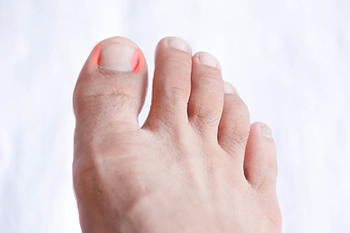 Ingrown toenails occur as a result of the sides and corners of the toenail digging and growing into the skin surrounding the nail. Common causes of ingrown toenails include poorly fitting shoes, improperly trimmed toenails, a toe injury, repetitive activities like soccer or running, sweaty feet, or obesity. Symptoms include pain or tenderness in the nail, swelling, redness, or a puss or odor coming from the nail. If an ingrown toenail becomes extremely painful or infected, it is important to visit a podiatrist. A podiatrist may elect to remove the nail or prescribe antibiotics for the infection. To prevent ingrown toenails from occurring or reoccurring, make sure to keep the feet clean and dry, trim your toenails in a straight line, and wear shoes that fit correctly.
Ingrown toenails occur as a result of the sides and corners of the toenail digging and growing into the skin surrounding the nail. Common causes of ingrown toenails include poorly fitting shoes, improperly trimmed toenails, a toe injury, repetitive activities like soccer or running, sweaty feet, or obesity. Symptoms include pain or tenderness in the nail, swelling, redness, or a puss or odor coming from the nail. If an ingrown toenail becomes extremely painful or infected, it is important to visit a podiatrist. A podiatrist may elect to remove the nail or prescribe antibiotics for the infection. To prevent ingrown toenails from occurring or reoccurring, make sure to keep the feet clean and dry, trim your toenails in a straight line, and wear shoes that fit correctly.
Ingrown toenails can become painful if they are not treated properly. For more information about ingrown toenails, contact Dr. Steven Sheridan of Ankle & Foot Specialty Clinics. Our doctor can provide the care you need to keep you pain-free and on your feet.
Ingrown Toenails
Ingrown toenails occur when a toenail grows sideways into the bed of the nail, causing pain, swelling, and possibly infection.
Causes
- Bacterial infections
- Improper nail cutting such as cutting it too short or not straight across
- Trauma to the toe, such as stubbing, which causes the nail to grow back irregularly
- Ill-fitting shoes that bunch the toes too close together
- Genetic predisposition
Prevention
Because ingrown toenails are not something found outside of shoe-wearing cultures, going barefoot as often as possible will decrease the likeliness of developing ingrown toenails. Wearing proper fitting shoes and using proper cutting techniques will also help decrease your risk of developing ingrown toenails.
Treatment
Ingrown toenails are a very treatable foot condition. In minor cases, soaking the affected area in salt or antibacterial soaps will not only help with the ingrown nail itself, but also help prevent any infections from occurring. In more severe cases, surgery is an option. In either case, speaking to your podiatrist about this condition will help you get a better understanding of specific treatment options that are right for you.
If you have any questions please feel free to contact our office located in Sandusky, MI . We offer the newest diagnostic and treatment technologies for all your foot and ankle needs.
